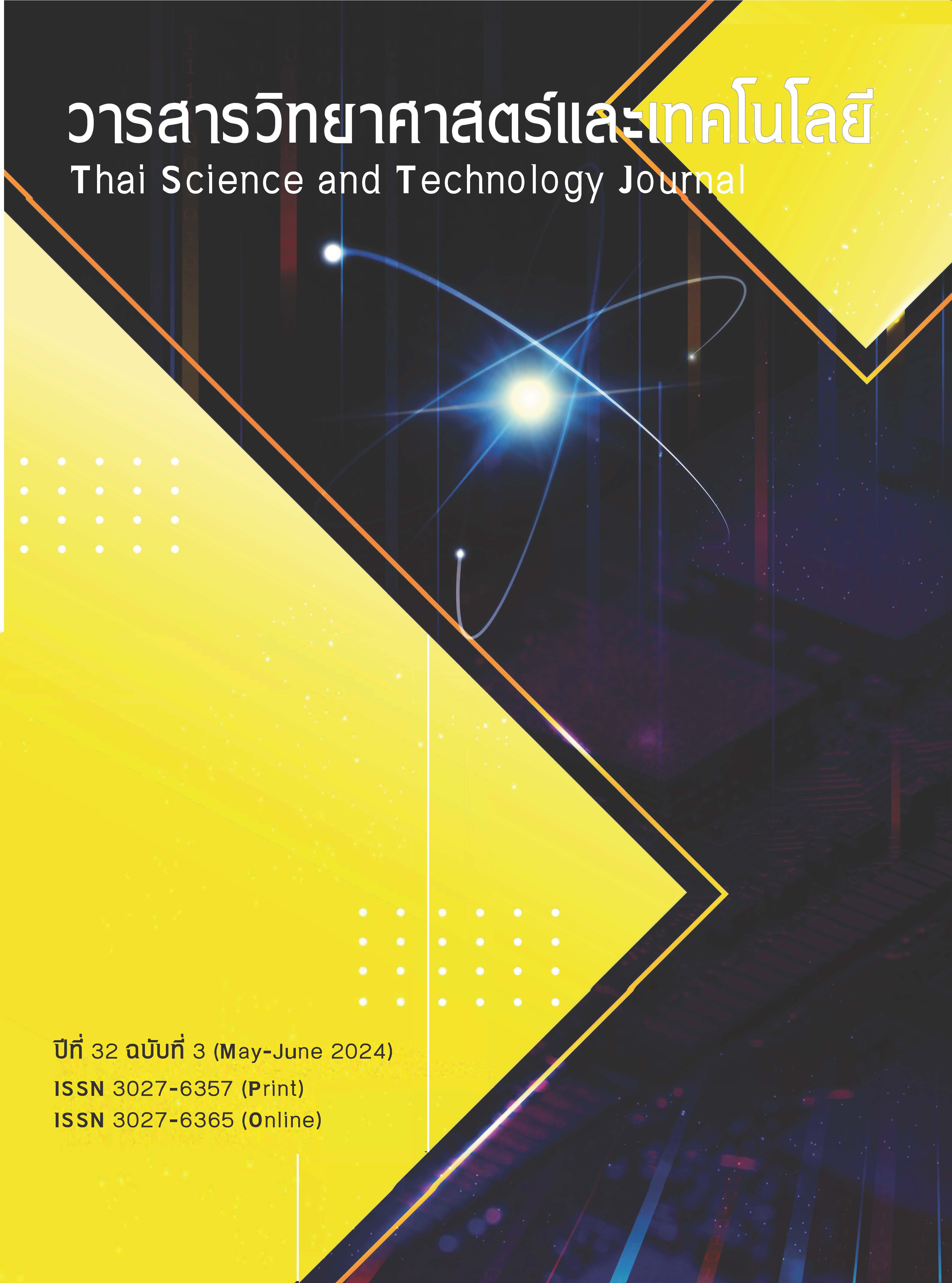ประสิทธิภาพของสารสกัดสมุนไพรไทยจากตำรับยาแผนไทยในการยับยั้งจุลินทรีย์ก่อโรคในมนุษย์และฤทธิ์ต้านอนุมูลอิสระ
Main Article Content
บทคัดย่อ
งานวิจัยนี้มีวัตถุประสงค์เพื่อประเมินศักยภาพของสารสกัดในการยับยั้งจุลินทรีย์และต้านอนุมูลอิสระจากสมุนไพรไทย 5 ชนิด ในตำรับยาแผนไทย นอกจากนี้ยังวิเคราะห์ปริมาณฟีโนลิกและฟลาโวนอยด์รวมด้วยวิธี Folin Ciocalteu และ colorimetric aluminum chloride ตามลำดับ โดยสกัดสารจากพืชสมุนไพร 5 ชนิด (ข้าวเย็นเหนือ ข้าวเย็นใต้ หนอนตายหยาก นมแมว และพุทธรักษา) ด้วยเอทานอลและเอทิลอะซิเตท จากนั้นประเมินฤทธิ์ยับยั้งจุลินทรีย์และต้านอนุมูลอิสระของสารสกัดจำนวน 10 สารสกัด ด้วยวิธี colorimetric broth microdilution, และ DPPH radical scavenging assays ตามลำดับ สำหรับการทดสอบฤทธิ์ยับยั้งจุลินทรีย์ ทดสอบจุลินทรีย์ 10 สายพันธุ์ ได้แก่ Staphylococcus aureus ATCC25923, Methicillin resistant Staphylococcus aureus (MRSA) SK1, Escherichia coli ATCC25922, Pseudomonas aeruginosa ATCC27853, Candida albicans ATCC90028, Candida albicans NCPF3153, Cryptococcus neoformans ATCC90112, Cryptococcus neoformans ATCC90113, Microsporum gypseum และ Taralomyces marneffei ผลการทดสอบพบว่าสารสกัดเอทานอลจากนมแมวมีฤทธิ์ในการยับยั้ง P. aeruginosa และ M. gypseum ได้ดีที่สุด MIC 0.4 มิลลิกรัมต่อมิลลิลิตร ตามด้วยสารสกัดเอทานอลจากข้าวเย็นเหนือมีฤทธิ์ยับยั้ง S. aureus MIC 0.8 มิลลิกรัมต่อมิลลิลิตร ขณะที่สารสกัดเอทานอลจากข้าวเย็นเหนือมีฤทธิ์ต้านอนุมูลอิสระ (DPPH) ได้ดีที่สุดให้ค่า IC50 3.08 ± 0.49 ไมโครกรัมต่อมิลลิลิตร ตามลำดับ นอกจากนี้ทดสอบหาปริมาณฟีโนลิกและฟลาโวนอยด์รวมพบว่าสารสกัดเอทานอลจากข้าวเย็นเหนือมีปริมาณฟีโนลิกและฟลาโวนอยด์สูงที่สุด 403.53 ± 0.83 มิลลิกรัมสมมูลของกรดแกลลิคต่อกรัมสารสกัด และ 21.23±0.16 มิลลิกรัมสมมูลของเคอร์ซิตินต่อกรัมสารสกัด ตามลำดับ จากผลการศึกษานี้ชี้ให้เห็นว่าสารสกัดจากสมุนไพรไทยในตำรับยาแผนไทยเป็นแหล่งของสารออกฤทธิ์ที่ดีสำหรับใช้ประโยชน์ในอนาคต
Article Details
เอกสารอ้างอิง
Indrawattana, N. and Vanaporn, M. 2015. Nosocomial infection. Journal of Medicine and Health Sciences. 22(1): 81-92. (in Thai)
Chungsamanukool, P. 2022. Incidence, Risk factors, mortality rate, and impact of multidrug-resistant gram-negative bloodstream infections in Photharam hospital. Medical Journal. 41(1): 579-592. (in Thai)
Virani, S., Bilheem, S., Chansaard, W., Chitapanarux, I., Daoprasert, K., Khuanchana, S., Leklob, A.,, Pongnikorn, D., Rozek, L.S., Siriarechakul, S., Suwanrungruang, K., Tassanasunthornwang, S., Vatanasapt, P. and Sriplung, H. 2017. National and Subnational-population-based incidence of cancers with the highest burdens. Cancers. 9(108) : 1-27.http://doi.org/10.3390/cancer9080108.
Chanvatik, S., Kosiyaporn, H., Lekagul, A., Kaewkhankhaeng, W., Vongmongkol, V., Thonyahan, A. and Tangcharoensathien, V. 2019. Knowledge and use of antibiotics in Thailand: A 2017 national household survey. PLOS ONE. 14(8) : e0220990.
dela Cruz, T.E.E., Notarte, K.I.R., Apurillo, C.C.S., Tarman, K. and Bungihan, M.E. 2020. Biomning fungal endophytes from tropical plants amd seaweeds for drug discovery. Biodiversity and Biomedicine. pp. 51-52.
Strobel, G., Daisy, B., Castillo, U. and Harper, J. 2004. Natural products from endophytic microorganisms. Journal of Natural Product. 67: 257-268.
El-Hady, H.H.A., Daboor, S.M. and Ghoniemy, A.E. 2007. Nutritive and antimicrobial profiles of some seagrasses from Bardawil lake, Egypt. Egyptian Journal of Aquatic Research. 33 : 103-110.
Newman, D.J., Cragg, G.M. and Snader, K.M., 2003, Natural products as sources of new drugs over the period 1981-2002, Journal of Natural Products. 66: 1022-1037.
Won, K.J., Lin, H.Y., Jung, S., Cho, S.M., Shin, H.C., Bae, Y.M., Lee, S.H., Kim, H.J., Joen, B.H., and Kim, B. 2012. Antifungal miconazole induces cardiotoxicity via inhibition of APE/REF-1-related pathway in rat neonatal cardiomyocytes. Toxicological Sciences. 126: 289-305.
Pim Wattanapanich, 1993. Folk medicine textbook (authentic) of Luang Pu Suk Wat Makham Thao and Krom Luang Chumphon Khet Udomsak. Trisin Printing. Bangkok. 112 pages. (in Thai)
Medini, F., Fellah, H., Ksouri, R. and Abdelly. 2014. Total phenolic, flavonoid and tannin contents and antioxidant and antimicrobial activities of organ extracts of shoots of the plant Limonium delicatulum. Journal of Taiban University for Science. 8(3): 216-224.
Kovac, J., Slobodnikova, L., Trajcikova, E., Rendekova, K., Mucaji, P., Sychrova, A. and Fialova, S.B. 2023. Therapeutic potential of flavonoids and tannins in management of Oral infectious disease- A review. Molecules. 28(1): 158. doi: 10.3390/molecules28010158
Clinical and Laboratory Standards Institute (CLSI). 2002a. Reference method for broth dilution antimicrobial susceptibility tests for bacteria that grow aerobically. Approved standard M7-A4. Clinical and Laboratory Standards Institute, Wayne, Pa.
Clinical and Laboratory Standards Institute (CLSI). 2002b. Reference method for broth dilution antimicrobial susceptibility testing of yeasts. Approved standard M27- A2. Clinical and Laboratory Standards Institute, Wayne, Pa.
Clinical and Laboratory Standards Institute (CLSI). 2002c. Reference method for broth dilution antimicrobial susceptibility testing of filamentous fungi. Approved standard M38-A. Clinical and Laboratory Standards Institute, Wayne, Pa.
Sarker, S.D., Nahar, L., and Kumarasamy, Y. 2007. Microtiterplate-based antibacterial assay incorporating resazurin as an indicator of cell growth, and its application in the in vitro antibacterial screening of phytochemicals. Methods. 42: 321-324.
Ghafar, M.F.A., Prasad, K.N. Weng, K.K. and Ismail, A. 2010. Flavonoid, hesperidine, total phenolic contents and antioxidant activities from citrus species. African Journal of Biotechnology. 9(3): 326-330.
Syukriya, A.J., Bankeeree, W., Prasongsuk, S. and Yanatatsaneejit, P. 2023. In vitro antioxidant and anticancer activities of Smilax corbularia extract combined with Phellinus linteus extract against breat cancer cell lines. Biomedical Reports. 19: 63; DOI: 10.3892/br.2023.1645
Jeeno, P., Tongban, S., Yana, P., Wongta, A., Sutan, K., Yadoung, S. and Hongsibsong, S. 2022. Tentative identification of phytochemicals from Smilax glabra and Smilax corbularia extracts by LC-QTOF/MS and their bioactive potential. Plants. 11(16) ; 2089; https://doi.org/10.3390/plants11162089
Xu, S. Shang, M.Y., Liu, G.X., Xu, F., Wang, X., Shou, C.C. and Cai, S.Q. 2013. Chemical constituents from rhizomes of Smilax glabra and their antimicrobial activity. Molecules. 18; 5265-5287. doi:10.3390/molecules18055265
Lalmuansangi, C., Lalremruati, M and Zothansiama. 2020. Assessment of free radicals scavenging activities and antioxidative potential of the tuber extracts of Stemona tuberosa Lour. Current Trends in Biotechnology and Pharmacy. 14(3): 347-358.
Rutnakornpituk, B., Boonthip, C., Kerdpan, J., Fakfeang, N. and Kholam, W. 2018. Antioxidant activity, total phenolic and flavonoid contents and analyses of active compounds in Stemona collinsae Craib crude extracts. International Journal of Science. 15(1); 25-36.
Singh, R. Bachheti, R.K., Saini, CK. And Singh, U. 2016. In vitro antioxidant activity of Canna indica extracts using different solvent system. Asian Journal of Pharmaceutical and clinical Reaearch. Asian J Pharm Clin Res 9(6): 53-56.
Al-Snafi, A. E. 2015. Bioactive components and pharmacological effects of Canna indica -anoverview. International Journal of Pharmacology and Toxicology. 5(2); 71-75.
Hosur, H. and Handral, M. 2021. A review on Canna indica and its pharmacological studies. World Journal of Pharmaceutical Research. 10(4); 2003-2012.
Jirakiattikul, Y., Autaijamsripon, J. and Rithichai, P. 2018. Effect of culture periods on antioxidant contents of in vitro Smilax corbularia shoots. Thai Science and Technology Journal. 27(6): 1066-1077. (in Thai)
Sanchez-Moreno, C., Jimenez-Escria, A. and Saura-Calixto. J., 2000, Study of low-density lipoprotein oxidizability indexes to measure the antioxidant activity of dietary polyphenols, Nutr Res, 20: 941-953.
Chantarapon, P., Bunpean, A., Sangjan, T. and Puksuk, N. 2023. A systematic review of herbal medicinal formulas for skin disease treatment with Thai traditioncal medicine wisdom. Journal of Thai Traditional and Alternative Medicine. 21(1): 175-185. (in Thai)


